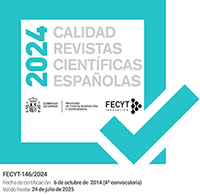Cancillería castellana y lengua vernácula : su proceso de consolidación
DOI:
https://doi.org/10.5944/etfiii.17.2004.3726Palabras clave:
diplomática, cancillería, Castilla,Resumen
La utilización de la lengua romance en la cancillería regia castellana fue resultado de un paulatino proceso que puede rastrearse a través de los numerosos documentos conservados y en los que se aprecia cómo se fue imponiendo al latín en función del contenido de los documentos y de su tipología. Los primeros indicios claros se detectan en la última etapa del reinado de Alfonso VIII, es decir, a finales del siglo XII y primeros años de la centuria siguiente. Su avance es incontestable en la época de Fernando III y en especial a partir de 1230. El triunfo del castellano en la documentación real — también notarial— se produce en la segunda mitad del siglo XIII, en el decisivo reinado de Alfonso X.
The use of the Romance language in the Castilian royal Chancellory was the result of a progressive process tracked through many documents preserved, and in which it is observed how it was imposing to the latin, according to the documents contents and their typology. The first clear signs are detected during the last years of the kingdom of Alphonse VII, that is to say, at the end of the 12th century, and during the first years of the following century. Its advance is unquestionable during Ferdinand III, and specially since 1230. The success of the Castilian language in the royal documentation —also in the notarial— happens in the second half of the 13th century, during the decisive kingdom of Alphonse X.
Descargas
Descargas
Publicado
Cómo citar
Número
Sección
Licencia
Los autores que publican en esta revista están de acuerdo con los siguientes términos:
- Los autores conservan los derechos de autor (copyright) de las obras publicadas y garantizan a la revista el derecho de ser la primera publicación del trabajo al igual que permiten la reutilización del mismo bajo la licencia de uso indicada en el punto 2.
- Las obras se publican en la edición electrónica de la revista bajo una licencia Creative Commons Reconocimiento-NoComercial 4.0 Internacional, que permite a otros compartir el trabajo con un reconocimiento de la autoría del trabajo y de la publicación inicial en esta revista. Se pueden copiar, usar, difundir, transmitir y exponer públicamente, siempre que: i) se cite la autoría y la fuente original de su publicación (revista, editorial y URL de la obra); ii) no se usen para fines comerciales.
- Se permite y se anima a los autores a difundir electrónicamente las versiones pre-print (versión antes de ser evaluada) y/o post-print (versión evaluada y aceptada para su publicación) de sus obras antes de su publicación, ya que favorece su circulación y difusión más temprana y con ello un posible aumento en su citación y alcance entre la comunidad académica (por ejemplo, en repositorios institucionales o en su propio sitio web). Color RoMEO: verde. (Véase The Effect of Open Access) (en inglés).
Authors who publish in this journal agree to the following terms:
- Authors retain copyright and grant the journal right of the first publication with the work simultaneously licensed under a Attribution-NonCommercial-NoDerivatives 4.0 International, that allows others to share the work with an acknowledgement of the work's authorship and initial publication in this journal.
- Authors are able to enter into separate, additional contractual arrangements for the non-exclusive distribution of the journal's published version of the work (e.g., post it to an institutional repository or publish it in a book), with an acknowledgement of its initial publication in this journal.
- Authors are permitted and encouraged to post their work online (e.g., in institutional repositories or on their website) prior to and during the submission process, as it can lead to productive exchanges, as well as to earlier and greater citation of the published work (See The Effect of Open Access).








